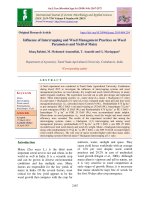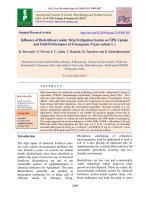Influence of biofertilizers under drip fertigation system on NPK uptake and yield performance of greengram (Vigna radiata L.)
Bạn đang xem bản rút gọn của tài liệu. Xem và tải ngay bản đầy đủ của tài liệu tại đây (294.44 KB, 9 trang )
Int.J.Curr.Microbiol.App.Sci (2019) 8(5): 2409-2417
International Journal of Current Microbiology and Applied Sciences
ISSN: 2319-7706 Volume 8 Number 05 (2019)
Journal homepage:
Original Research Article
/>
Influence of Biofertilizers under Drip Fertigation System on NPK Uptake
and Yield Performance of Greengram (Vigna radiata L.)
K. Shravani*, S. Triveni, P. C. Latha, V. Ramulu, M. Tejashree and K. Damodharachari
Department of Agricultural Microbiology & Bioenergy, College of Agriculture, Professor
Jayashankar Telangana State Agricultural University, Rajendranagar, Hyderabad-500030,
Telangana, India
*Corresponding author
ABSTRACT
Keywords
Liquid biofertilizers,
Biofertgation, precision
farming system,
Microbial inoculants
(Rhizobium and PSB)
Article Info
Accepted:
18 April 2019
Available Online:
10 May 2019
Field experiment was conducted at water technology centre fields, college farm, College of
Agriculture, PJTSAU, Rajendranagar, Hyderabad, Telangana during kharif 2016 – 2017
with one of the objective of nutrient uptake and yield performance of Greengram, variety
(MGG – 295) under Drip fertigation system. The experiment was laid out in Randomizerd
block design with three replications. Use of carrier based inoculum for crop growth and
yield is wide practice among the conventional agriculture. Precision farming is a site
specific management approach whereas the conventional practice is a uniform fertilizer
application. Carrier based inoculum is not suitable for precision farming system due to
clogging effect. Hence the liquid bioinoculants viz., Rhizobium and PSB were used under
drip fertigation system to evaluate the yield performance and NPK uptake of greengram.
The result suggested the positive influence of 100% RDF of NPK + Rhizobium (LB) and
PSB (LB) under drip fertigation the flow rate was 2 lit hr-1 on delivery of microbial
inoculants Rhizobium (8.38 log no. of cells ml-1) and PSB (8.15 log no. of cells ml-1) were
increased the NPK uptake and 23.93 % yield over conventional method.
Introduction
The high inputs of chemical fertilizers have
not only caused environmental problems but
also became a cause of concern for human
health. Biofertilizers have been identified to
address the issue of excessive use of chemical
fertilizers. Biofertilizers are one of the
sustainable sources of supplementation to
chemical fertilizers for Agriculture. The term
Biofertilizers generally are defined as
preparation containing live or latent cells of
efficient strains of Nitrogen fixing,
Phosphorus solubilizing or cellulolytic
microorganisms used for application to seed or
soil. It is also playing an important role for
supplementing the essential plant nutrients for
sustainable agriculture, economy and ecofriendly environment.
Biofertilizers are low cost and economically
viable technology which improves plant
growth and development. These are reduce the
environmental pollution caused by chemical
fertilizers, protect plants against many soilborne pathogens and help the plant to grow
2409
Int.J.Curr.Microbiol.App.Sci (2019) 8(5): 2409-2417
under stress conditions (Brahmaprakash and
Sahu, 2012).
Liquid biofertilizers of good quality hold great
promise in agriculture because of benefits over
the conventional carrier based biofertilizers
such as liquid biofertilizers contains special
cell protectants or substances that encourage
the formation of resting spores or cysts for
longer shelf life (Chandra et al., 2005) and
protect the cells against seed toxicity after
seed application; provide better resistance
against abiotic stress, high temperature (up to
55oC), desiccation and osmotic shocks, better
survival on seed and better nodulation; cost
saving on carrier material such as
pulverization, neutralization, sterilization,
contamination free and convenience of
handling, storage and transportation.
Greengram (Vigna radiate L. Wilczek) is an
ancient and well known third most important
pulse crop in India, on account of its
nutritional quality, early maturing and the
suitability in cropping systems. India is a
leading green gram cultivator, with up to 55%
of the total world acreage and 45% of total
production (Singh et al., 2013; Rishi et al.,
2009). It is one of the most important pulse
crop for protein supplement.
Efficient management of water is of outmost
importance for sustaining and enhancing
Agricultural production (Palanisami et al.,
2012). Drip fertigation allows precise timing
and uniform distribution of fertilizer nutrients,
and is an efficient and agronomically sound
method of providing soluble plant nutrients
directly to the active plant root zone.
Biofertigation is the efficient and precise use
of beneficial microorganisms through a
microirrigation system. Biofertigation offers
vast scope for minimizing the use of chemical
fertilizers. There are more chances for
increasing the yield, quality, fertilizer-use
efficiency, water-use efficiency, and economic
output. With drip fertigation and in
combination with organics, there is possibility
for organic farming to be intensified in the
future.
Materials and Methods
The field experiment was conducted at water
technology centre fields, college farm, College
of Agriculture, PJTSAU, Rajendranagar,
during kharif 2016 – 2017. The location is
geographically situated at 17° N Latitude and
78° E longitude at an altitude of 542.3 m
above MSL. The soil of n experimental site
was sandy loam in texture, moderate in
organic carbon, low in nitrogen and medium
in available phosphorus and high in potash
and slightly alkaline (pH 7.6) in chemical
reaction.
The experiment was laid out in a Randomized
Block Design with 10 treatment combinations.
The treatments are T1: 100 % RDF, T2 : 100
% RDF + CBBF Seed treatment, T3: 100 %
RDF + CBBF Soil treatment, T4: 100 % RDF
+ LBBF Seed treatment, T5: 100 % RDF +
LBBF Soil treatment, T6: 100 % RDF +
LBBF Drip fertigation, T7: 100 % RDF +
LCBF Seed treatment, T8: 100 % RDF +
LCBF Soil treatment, T9: 100 % RDF +
LCBF Drip fertigation, T10 Control: Only
biofertilizers. Sowing was done on 15th July,
2016 by hand dibbling two to three seeds at
each hill at a recommended spacing of 30 cm
× 10 cm. Recommended dose of fertilizer for
greengram is 20: 50: 00 N P K kg ha–1.
Fertilizer viz., nitrogen, phosphorus were
applied in respective plots as per the
recommendation by using the urea and SSP.
Each plot was measured 25.2 m2. The drip
lines were arranged for the treatments of T6
(LBBF) & T9 (LCBF) plots and the drip
system was checked for its flow rate. The two
drip irrigated plots (T6 & T9) had six drip line
laterals each. The lateral spacing was 0.6 m.
2410
Int.J.Curr.Microbiol.App.Sci (2019) 8(5): 2409-2417
The flow rate was 2 lph (liters per hour). The
two treatments were supplied with an
independent fertigation system consist of a
drip tubes and controlled tapes. A tank filled
with fertigation water was placed 1 m above
the ground to maintain enough water pressure
1 kg /cm2. Surface irrigation was given as and
when cumulative pan evaporation (CPE) value
reached the level of 83 mm, which is in
accordance with IW/CPE ratio of 0.60.
The fertilizer solution was prepared by
dissolving the required quantity of fertilizer
with water in 1:5 ratio and liquid biofertilizers
Rhizobium (10 ml) + PSB (10ml) injected into
the irrigation system through venturi
assembly. Fertigation interval was scheduled
once in 7 days interval. The recommended
doses (20: 50: 00 NPK kg ha-1) of inorganic
fertilizers i.e., urea (46 % N) and single super
phosphate (16 % P2O5) were applied as basal
to the surface irrigated treatments except
fertigation treatment (T6 & T9) combinations.
Data were collected for greengram nutrient
uptake and seed yield and haulm yield at
harvest stage. The nutrient content uptake
values obtained as percentage in the analysis
was multiplied by the respective dry matter
content for computing N, P and K uptake
expressed in kg ha-1.
Percentage of nutrient content ×
Total dry matter production (kg ha-1)
Nutrient uptake (kg ha-1) = ----------------------100
compared to all other treatment combinations.
This might be due to excess irrigation in
surface irrigation methods, fertilizer nutrients
might have been leached beyond the root
zone, whereas in drip fertigation, fertilizers
were applied through drip irrigation in desired
split doses throughout the growing period
according to crop requirements, so that the
losses were minimized and opportunity was
provided to take up more nutrients, which
reflected on the higher plant growth rate
Sathiyaraj (2010).
The Similar findings of higher nutrient uptake
with drip fertigation over soil application of
nutrients were also reported by Veeraputhiran
(2000) in hybrid cotton. Jayakumar et al.,
(2014) reported that drip fertigation in cotton
with 150 per cent recommended dose of N, P,
K and biofertigation was significantly superior
in nutrient uptake with the highest N, P and K
uptake of 110.9, 28.2 and 110.6 kg ha-1 at 120
DAS, respectively. Similar results with drip
biofertigation at 125 per cent RDF through
water soluble fertilizer with Azophosmet and
1 % PPFM foliar spray recorded higher
nitrogen uptake founded by (Jeyajothi et al.,
2017). Bharathi et al., (2017) concluded that
the nutrient uptake of bhendi was increased
with 75 % RDF of N, P, K fertilizer along
with single dose of microbial consortium as a
biofertigation has significantly increased the
N, P, K uptake in bhendi.
Yield performance of greengram with drip
biofertigation
Results and Discussion
Influence of biofertigation on nutrient
uptake by greengram plant
The data regarding to uptake of NPK (Table 1)
was significantly noticed maximum uptake by
application of liquid based biofertilizers
through drip as fertigation with treatment T6
(100 % RDF + LBBF drip fertigation) when
The data regarding significantly highest yield
(Table 3) and yield attributing characters
(Table 2) viz., number of pods plant-1, number
of seeds pod-1, test weight (g), Seed yield (kg
ha-1) and haulm yield (kg ha-1) were registered
with combined application of liquid
biofertilizers and mineral fertilizers with drip
fertigation in treatment T6 (100 % RDF +
LBBF drip fertigation) (Fig. 1–6).
2411
Int.J.Curr.Microbiol.App.Sci (2019) 8(5): 2409-2417
Table.1 Influence of different formulations of biofertilizers application on nutrient uptake of
greengram at harvesting stage
N (kg ha-1)
P kg ha-1)
K (kg ha-1)
T1 : 100 % RDF
T2 : 100 % RDF + CBBF Seed treatment
45.80
56.27
18.17
23.77
41.77
47.87
T3 : 100 % RDF + CBBF Soil treatment
T4 : 100 % RDF + LBBF Seed treatment
53.60
58.10
20.77
24.10
45.60
49.77
T5 : 100 % RDF + LBBF Soil treatment
T6 : 100 % RDF + LBBF Drip fertigation
T7 : 100 % RDF + LCBF Seed treatment
T8 : 100 % RDF + LCBF Soil treatment
52.23
62.23
53.27
50.60
21.03
26.60
21.23
19.80
46.07
51.33
47.87
45.43
T9 : 100 % RDF + LCBF Drip fertigation
T10 Control : Only biofertilizers
SE(m)
CD(P=0.05)
CV
54.37
41.30
2.91
8.71
9.54
23.53
16.50
1.39
4.17
11.21
46.80
43.33
1.48
4.43
5.50
Treatments
Table.2 Influence of different formulations of biofertilizers application on yield attributing
characters of greengram at harvest stage
Treatments
T1 : 100 % RDF
T2 : 100 % RDF + CBBF Seed treatment
No. of pods
plant-1
11.67
16.67
No. of Seeds
pod-1
10.33
11.00
Test weight of
seeds (g)
29.40
37.30
T3 : 100 % RDF + CBBF Soil treatment
T4 : 100 % RDF + LBBF Seed treatment
T5 : 100 % RDF + LBBF Soil treatment
14.33
17.33
14.67
11.00
12.00
12.00
36.20
37.80
36.30
T6 : 100 % RDF + LBBF Drip fertigation
19.67
13.00
38.77
T7 : 100 % RDF + LCBF Seed treatment
14.67
11.00
36.50
T8 : 100 % RDF + LCBF Soil treatment
13.33
10.33
31.50
T9 : 100 % RDF + LCBF Drip fertigation
T10 Control : Only biofertilizers
SE(m)
16.00
10.00
1.12
11.67
8.00
0.67
37.00
22.30
0.87
CD(P=0.05)
3.37
2.02
2.61
CV
13.14
10.62
4.41
2412
Int.J.Curr.Microbiol.App.Sci (2019) 8(5): 2409-2417
Table.3 Influence of different formulations of biofertilizers application on seed yield and haulm
yield of greengram
Treatments
T1 : 100 % RDF
T2 : 100 % RDF + CBBF Seed treatment
T3 : 100 % RDF + CBBF Soil treatment
T4 : 100 % RDF + LBBF Seed treatment
T5 : 100 % RDF + LBBF Soil treatment
T6 : 100 % RDF + LBBF Drip fertigation
T7 : 100 % RDF + LCBF Seed treatment
T8 : 100 % RDF + LCBF Soil treatment
T9 : 100 % RDF + LCBF Drip fertigation
T10 Control : Only biofertilizers
SE(m)
CD(P=0.05)
CV
Seed yield
(kg ha-1)
0821.67
0945.70
0875.50
0960.77
0880.23
1019.50
0890.20
0850.23
0930.80
0721.77
26.32
78.82
5.12
Per cent
increase
over RDF
(%)
15.09
06.55
16.83
07.08
23.93
08.29
03.45
13.20
-
Haulm yield
(kg ha-1)
1980.23
2450.20
2310.20
2506.70
2350.07
2543.50
2380.57
2256.97
2420.23
1750.23
72.65
217.55
5.48
Per cent
increase
over RDF
(%)
23.73
16.66
26.32
18.48
28.16
20.17
13.83
22.00
-
Fig.1 Influence of different formulations of biofertilizers application on nutrient uptake of
greengram at harvesting stage
2413
Int.J.Curr.Microbiol.App.Sci (2019) 8(5): 2409-2417
Fig.2 Influence of different formulations of biofertilizers application on number of pods plant-1of
greengram at harvest stage
Fig.3 Influence of different formulations of biofertilizers application on number of pods plant-1of
greengram at harvest stage
Fig.4 Influence of different formulations of biofertilizers application on test weight (g) of
greengram at harvest stage
2414
Int.J.Curr.Microbiol.App.Sci (2019) 8(5): 2409-2417
Fig.5 Influence of different formulations of biofertilizers application on seed yield of greengram
Fig.6 Influence of different formulations of biofertilizers application on haulm yield of
greengram
It might be due to biofertigation can precisely
deliver the bio inoculants in the root zone
(Gomathy et al., 2008). It is an added
advantage whereas microbial inoculants are
supplied through biofertigation as it has more
water use efficiency and fertilizer use
efficiency,
quality
etc.
Effective
microorganisms and can also applied in the
field along with inorganic materials (Hussain
et al., 1999). Liquid formulations of microbial
2415
Int.J.Curr.Microbiol.App.Sci (2019) 8(5): 2409-2417
resources could be a potential organic input
for precision farming, which can be easily
delivered through fertigation system for
effective colonization of root zone of crop
plants.
Bacillus (7.00 ± 0.12 ml log cells ml-1) and
Pseudomonas (7.30 ± 0.02 log cells ml-1),
plant growth and 10 % increased yield over
conventional method. Jeyajothi et al., (2017)
founded similar results in pigeonpea.
The fertigation with liquid based biofertilizers
and 100 % RDF resulted in higher availability
of all three major nutrients (N, P and K) in the
soil solution, which led to higher uptake and
better translocation of assimilates from source
to sink, thus in turn increased the yield.
Similar linear response was obtained in long
duration pigeonpea under drip fertigation by
Vimalendren and Latha (2014).
Precision farming is one among the integrated
management approaches of agriculture, which
include fertigation and combined practice of
organic and inorganic farming to get highest
yield and to minimize the cost of farming.
Fertigation system of precision farming is
considered as effective delivery of nutrients
exactly at the root zone of crop, which
minimize the loss as well as reduce the
environmental hazards caused by the
chemicals. This technology ensures the
fertilizer use effectively to a greater extent.
Biofertigation can precisely deliver the bio
inoculants in the root zone (Gomathy et al.,
2008). It is an added advantage whereas
microbial inoculants are supplied through
biofertigation as it has more water use
efficiency and fertilizer use efficiency, quality
etc. Effective microorganisms can also
applied in the field along with inorganic
materials (Hussain et al., 1999).
The above results were in line with
Senthilkumar
et
al.,
(2014)
100%
recommended dose of fertilizers through
fertigation (RDFTF) with 300 g of consortium
of biofertilizers (CBF) recorded significantly
higher yield attributing characters. The
similar results were obtained by using
biofertigation in different crops found by
Gomathy et al., (2008) reported that
application of 150 % of recommended NPK
as
drip
fertigation
combined
with
biofertigation of liquid formulation of
azophosmet was significantly better and
increased the growth parameters and yield
attributes of cotton.
Jayakumar et al., (2014) reported that
application of 150 per cent RDF as drip
fertigation combined with biofertigation of
liquid formulation of azophosmet @ 250 ml
(1012 cells ml-1) ha-1 registered the highest
seed cotton yield of 3395 kg ha-1. Bharathi et
al., (2017) conducted a field trail experiment
to study the effect of biofertigation on plant
growth under precision farming system in
Bhendi (COBH 1). The result suggested the
positive influence of 75 % RDF of NPK +
Microbial consortium application with single
time (60 lit ha-1) on delivery of inoculants
viz., Azospirillum (5.96 ± 0.12 log cells ml-1),
The results clearly confirmed that bio
fertigation could be an effective system which
increased the ultimate output of yield.
Abbreviations
RDF: Recommended dose of NPK fertilizers
LBBF: Liquid based biofertilizers
CBBF: Carrier based biofertilizers
LCBF: Liquid culture based biofertilizers
References
Bharathi, J., Balachander, D., Kumar, K and
Narayanan, R. 2017. Evaluation of new
microbial
consortium
through
biofertigation for precision farming of
bhendi (cobh 1). International Journal
2416
Int.J.Curr.Microbiol.App.Sci (2019) 8(5): 2409-2417
of Medical Sciences & Pharmaceutical
Research. 1(1): 15-24.
Brahmaprakash, G.P and Sahu, P.K. 2012.
Biofertilizers for Sustainability. Journal
of Indian Institute of Science. 92: 37-62.
Chandra, K., Greep, S., Ravindranath, P and
Srivathsa,
R.S.H.
2005.
Liquid
Biofertilizers (Government of India,
Ministry of Agriculture, Department of
Agriculture and Cooperation, Regional
Center for Organic Farming). Regional
Director, Regional Center for Organic
Farming, Bangalore.
Gomathy, M., Sathya, P.D., Thangaraju, M.,
Sundaram, S.P and Manicka, S.P. 2008.
Impact of biofertigation of Azophosmet
on cotton yield under drip irrigation.
Research Journal of Agriculture and
Biological Sciences. 4(6): 695-699.
Hussain, T., Javaid, T., Parr, J.F., Jilani, G
and Haq, M.A. (1999). Rice and wheat
production in Pakistan with effective
microorganism. Am. J. Alt. Agric. 1: 3036.
Jayakumar,
M.,
Surendran,
U.,
Manickasundram, P. 2014. Drip
fertigation effects on yield, nutrient
uptake and soil fertility of Bt Cotton in
semi-arid tropics. International Journal
of Plant Production. 8 (3): 1-16.
Jeyajothi, R and Pazhanivelan, S. 2017. Dry
matter, nutrient uptake and yield of
short duration pigeon pea (Cajanus
cajan L.) varieties under drip fertigation
system. International Journal of
Current Microbiology and Applied
Sciences. 6 (11): 3958-3965.
Palanisami, K.K., Mohan, K. R., Kakumanu
and Raman, S. 2012. Spread and
economics of micro irrigation in India:
Evidence from different states. 258-266.
Rishi, N. 2009. Significant plant virus
diseases in India and a glimpse of
modern
disease
management
technology. J. Gen. Plant Pathol. 75: 1–
18.
Sathiyaraj, M. 2010. Study on the influence of
irrigation regimes and fertigation levels
on sugarcane under subsurface drip
fertigation system. Ph.D. Thesis. Tamil
Nadu Agric. Univ., Madurai.
Senthilkumar, M., Ganesh, S., Paneerselvam,
P and Srinivas, K. 2014. Influence of
fertigation
and
consortium
of
biofertilizer
on
photosynthesis,
chlorophyll content yield parameters
and yield of banana cv. robusta (AAA).
Plant Archives. 14(1): 387-391.
Singh, N., Singh, H and Nagarajan, P. 2013.
Development of SSR markers in mung
bean, Vigna radiata (L.) Wilczek using
in silico methods. J. crop weed. 9: 69–
74.
Veeraputhiran, R. 2000. Drip fertigation
studies in hybrid cotton. Ph.D. Thesis,
Tamil Nadu Agric. Univ. Coimbatore.
Vimalendran. L and K.R. Latha. 2014. Yield,
water use and water use efficiency of
pigeonpea [Cajanus cajan (L.) Millsp.]
under drip fertigation system. JANS.
6(1): 457-462.
How to cite this article:
Shravani K., S. Triveni, P. C. Latha, V. Ramulu, M. Tejashree and Damodharachari, K. 2019.
Influence of Biofertilizers under Drip Fertigation System on NPK Uptake and Yield
Performance of Greengram (Vigna radiata L.). Int.J.Curr.Microbiol.App.Sci. 8(05): 24092417. doi: />
2417
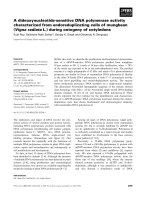




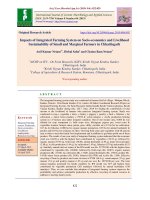
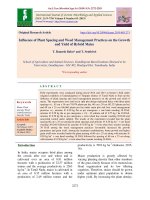
![Effect of fertility levels and stress mitigating chemicals on nutrient uptake, yield and quality of mungbean [Vigna radiata (L.) Wilczek] under loamy sand soil of Rajasthan](https://media.store123doc.com/images/document/2020_01/09/medium_ftp1578562755.jpg)
